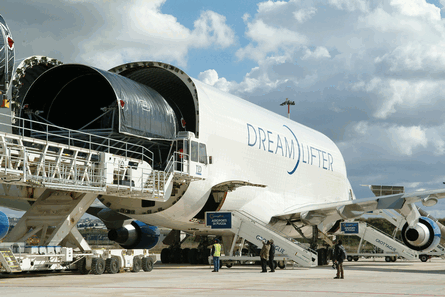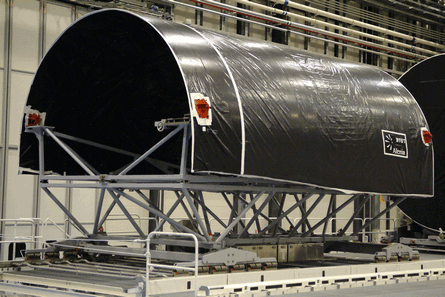In June, Alenia Composite became the first 787 partner to deliver completed sections to final assembly, when it supplied a Section 44 bonnet structure for the centre fuselage barrel of Dreamliner Seven. However, its campaign to iron out glitches in the production process was interrupted by the Boeing machinists' strike, which began on 6 September.
Alenia Composite, wholly owned by Alenia Aeronautica, uses one-piece barrel technology to manufacture composite fuselage sections 44 and 46 at its custom-built Grottaglie facility, in the heel of Italy's boot. The other element of its three-piece empennage and fuselage shipset, the horizontal stabiliser, is manufactured at Alenia's plant in Foggia, 230km (140 miles) north-west of Grottaglie. The stabiliser, 19.8m (65ft) long, incorporates what is claimed to be the largest fully co-cured, solid-laminate monolithic composite piece ever produced for a commercial aircraft.
To date 10 shipsets have been completed, including two sent to Seattle for static testing (now complete) and fatigue testing (to start shortly). While initial problems led to some "travelled work" - elements of work undertaken out of sequence - the quality of structural components manufactured by Alenia were reported to be improving markedly during the summer. Then the machinists' strike intervened.
 |
|---|
© Alenia Aeronautica |
"We have been obliged to put the brake on production," says Alenia Composite's chief operating officer Roberto Polidoro. "The kind of 'lessons learned' effect that we had expected in this time has been postponed to the right of the schedule."
While the Grottaglie caters specifically to the 787, other resources have been redeployed due to the strike. "We have the advantage of being in Alenia Aeronautica, so we are moving resources between different programmes - human, financial, any kinds of resources," says Polidoro. "We're used to managing this kind of adjustment within our company."
The slowdown on the 787 has coincided with continuing success for Alenia's C-27J Spartan tactical transport. On 23 October the company confirmed a €130 million ($175 million) deal to supply Morocco with four C-27Js, swelling its orderbook to 121 aircraft. Previous buyers include Bulgaria, Greece, Italy, Lithuania, Romania and the USA.
FOLLOW-ON WORK
Alenia's 787 involvement grew out of fuselage and structural assembly work it executed for the 767 and 777 programmes, itself a follow-on from work on the 717 and 757 programmes. When Boeing elected to pursue a new mid-market widebody programme, Alenia got on board early. In February 2002 its parent company Finmeccanica agreed to co-operate on the Sonic Cruiser, and remained involved after the Sonic Cruiser became the 7E7 and the 7E7 became the 787.
An August 2005 contract provided for a formal role in development and production of the 787. This covered an initial order of components for 150 aircraft. The contract, with an estimated value of $1.1 billion, necessitated investment of around $640 million over three years, with most of it directed toward development of the Grottaglie site. A one-piece barrel building was constructed at Grottaglie to produce the 8.5m-long Section 44 and 10m-long Section 46. Construction of the building - which is 400m long, 175m wide and 24m tall - required 50,000m3 (1.76 million ft3) of concrete and 20,000t of steel. The autoclave housed within - claimed to be the largest in Europe, with dimensions of 19.5 x 9m - processes fuselage barrels with a cure cycle of 16h, while a 17 x 36m automated fibre-placement machine wraps 1,820kg (4,000lb) of composite tape around a mandrel for each Section 44. Plans to acquire a second autoclave were revealed in the summer.
 |
|---|
© Alenia Aeronautica |
Alenia's role in the 787 programme is deepened by its involvement as a joint venture partner in Global Aeronautica, a 50:50 arrangement with Vought Aircraft Industries until Boeing acquired that company's stake in June. Located at Charleston, South Carolina, Global Aeronautica is responsible for preassembly of the fuselage sections. Between them, Alenia Composite and Global Aeronautica manufacture 26% of the 787's structure and 60% of its fuselage.
SOWING THE SEEDS
Unfinished barrels are transported to Charleston using a Boeing 747LCF, requiring an extension of the runway at Grottaglie, from 1,800m to 3,200m. Beyond investments in equipment and facilities, the 787 programme requires Alenia to co-operate closely with suppliers to ensure that the risk it shares is minimised. "We are a tier-one supplier to Boeing, our customer, but if we turn our head to the other side we see a supply chain that is very complex," says Polidoro. "We have some suppliers - tier two for Boeing, but of course they're tier one for us - which control a lot of other suppliers. So, if the question is: is it difficult? My answer is yes. If the question is: are you capable? The answer is again yes. It is mandatory to control our entire supply chain to participate in a programme like this. So it's complex, and the organisation also is complex - with different plants, plus a customer which is very demanding - and this is the reason why we have core suppliers that perform."
Work continues to refine the technologies developed for the 787. "Composites are the king of weight optimisation, and we are fully involved with weight optimisation projects," says Polidoro. "To a different extent we are also involved in aerodynamic improvement, for instance for the horizontal stabiliser."
Naturally, Polidoro expects long-term rewards for its investments. "We are sure that we will have much more composite present in the next programme in which we will participate," he says. "The level of composite, which today is around 50%, will increase. The technology to use the composites together with the metals - aluminium - is difficult technology that we have, and we will use also this in the [next] programme."
The 787 remains "a successful programme" with nearly 900 orders logged, he adds. "We're participating with a high percentage of work sharing - and with huge investment, but that will be used also on other programmes," Polidoro says. "We are very happy to be there because it's a programme with stable margins and with good revenues in future on the other programmes."
For all the 787's travails, Polidoro remains convinced that it "represents how civil airframes will be made in the future".
Source: Flight International























